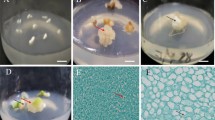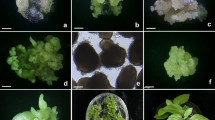Abstract
An efficient maize regeneration system was developed using mature embryos. Embryos were removed from surface-sterilized mature seeds and sliced into halves. They were used as explants to initiate callus on induction medium supplemented with 4.0 mg l−1 2,4-dichlorophenoxyacetic acid (2,4-D). The induction frequency of primary calli was over 90% for all inbred lines tested. The primary calli were then transferred onto subculture medium supplemented with 2.0 mg l−1 2,4-D. Following two biweekly subcultures, embryogenic calli were formed. Inclusion of a low concentration (0.2 mg l−1) of 6-benzylaminopurine (BA) in the subculture medium significantly promoted the formation of embryogenic callus. The addition of silver nitrate (10 mg l−1) also supported an increased frequency of embryogenesis. The embryogenic callus readily formed plantlets on regeneration medium supplemented with 0.5 mg l−1 BA. The regenerated plantlets were transferred to half-strength Murashige and Skoog medium supplemented with 0.6 mg l−1 indole-3-butyric acid to develop healthy roots. The regenerated plantlets were successful on transfer to soil and set seed. Using this system, plantlets were regenerated from seven elite maize inbred lines. The frequency of forming green shoots ranged from 19.8% to 32.4%. This efficient regeneration system provides a solid basis for genetic transformation of maize.




Similar content being viewed by others

Abbreviations
- BA :
-
6-Benzylaminopurine
- 2,4-D :
-
2,4-Dichlorophenoxyacetic acid
- IBA :
-
Indole-3-butyric acid
- KT :
-
Kinetin
References
Akula C, Akula A, Henry R (1999) Improved regeneration efficiency from mature embryos of barley cultivars. Biol Plant 42:505–513
Armstrong CL, Green CE (1985) Establishment and maintenance of friable, embryogenic maize callus and involvement of l-proline. Planta 164:207–214
Beyer EM (1976) A potent inhibitor of ethylene action in plants. Plant Physiol 58:268–271
Bhaskaran S, Smith RA (1990) Regeneration in cereal tissue culture: a review. Crop Sci 30:1328–1336
Bohorova NE, Luna B, Briton RM, Huerta LD, Hoistington DA (1995) Regeneration potential of tropical, and subtropical, midaltitude, and highland maize inbreds. Maydica 40:275–281
Bohorova NE, Zhang W, Julstrum P, McLean S, Luna B, Briton RM, Diaz L, Ramos ME, Estanol P, Pacheco M, Salgado M, Hoistington DA (1999) Production of transgenic tropical maize with crylAb and crylAc genes via microprojectile bombardment of immature embryos. Theor Appl Genet 99:437–444
Carvalho CHS, Bohorova N, Bordallo PN, Abreu LL, Valicentle FH, Bressan W, Paiva E (1997) Type II callus production and plant regeneration in tropical maize genotypes. Plant Cell Rep 17:73–76
Chang Y, von Zitzewitz J, Hayes PM, Chen THH (2003) High frequency plant regeneration from immature embryos of an elite barley cultivar (Hordeum vulgare L. cv. Morex). Plant Cell Rep 21:733–738
Chaudhury A, Qu R (2000) Somatic embryogenesis and plant regeneration of turf-type Bermuda grass: effect of 6-benzyladenine in callus induction medium. Plant Cell Tissue Organ Cult 60:113–120
Cho MJ, Jiang W, Lemaux PG (1998) Transformation of recalcitrant barley cultivars through improvement of regenerability and decreased albinism. Plant Sci 138:229–244
Choi H, Lemaux PG, Cho M (2001) Selection and osmotic treatment exacerbate cytological aberrations in transformed barley (Hordeum vulgare L.). J Plant Physiol 158:935–943
Chu CC, Wang CC, Sun CS, Hus C, Yin KC, Chu CY, Bi FY (1975) Establishment of an efficient medium for another culture of rice through comparative experiments on the nitrogen sources. Sci Sin 18:659–668
Conger BV, Novak FJ, Afza R, Erdelsky KE (1987) Somatic embryogenesis from cultured leaf segments of Zea mays. Plant Cell Rep 6:345–347
Dahleen LS, Bregitzer P (2002) An improved media system for high regeneration rates from barley immature embryo-derived callus cultures of commercial cultivars. Crop Sci 42:934–938
Duncan DR, Widholm JM (1988) Improved plant regeneration from maize callus cultures using 6-benzylaminopurine. Plant Cell Rep 7:452–455
Duncan DR, Williams ME, Zehr BE, Widholm JM (1988) The production of callus capable of plant regeneration from immature embryos of numerous Zea mays genotypes. Planta 165:322–332
Fernandez S, Michaux-Ferriere N, Coumans M (1999) The embryogenic response of immature embryo cultures of durum wheat (Triticum durum Desf): histology and improvement by AgNO3. Plant Growth Regul 28:147–155
Gamborg OL, Miller RA, Ojima K (1968) Nutrient requirements of suspension cultures of soybean root cells. Exp Cell Res 50:151–158
Gaspar T, Kevers C, Penel C, Greppin H, Reid DM, Thorpe TA (1996) Plant hormones and plant growth regulators in plant tissue culture. In Vitro Cell Dev Biol Plant 32:272–289
Green CE, Phillips RL (1975) Plant regeneration from tissue culture of maize. Crop Sci 15:417–421
Green CE, Phillips RL, Kleese RA (1974) Tissue culture of maize (Zea mays L.): initiation, maintenance, and organic growth factors. Crop Sci 14:54–58
Ishida Y, Satto H, Ohta S, Hiei Y, Komari T, Kumashiro T (1996) High efficiency transformation of maize (Zea mays L.) mediated by Agrobacterium tumefaciens. Nat Biotechnol 14:745–750
Lu C, Vasil IK (1983) Improved efficiency of somatic embryogenesis and plant regeneration in tissue cultures of maize (Zea mays L.). Theor Appl Genet 66:285–289
Lu C, Vasil IK, Ozias-Akins P (1982) Somatic embryogenesis in Zea mays L. Theor Appl Genet 62:109–112
Murashige T, Skoog F (1962) A revised medium for rapid growth and bio-assays with tobacco tissue cultures. Physiol Plant 15:473–497
O’Connor-Sánchez A, Cabrera-Ponce JL, Valdez-Melara M, Téllez-Rodríguez P, Pons-Hernández JL, Herrera-Estrella L (2002) Transgenic maize plants of tropical and subtropical genotypes obtained from calluses containing organogenic and embryogenic-like structures derived from shoot tips. Plant Cell Rep 21:302–312
Özgen M, Türet M, Altmok S, Sancak C (1998) Efficient callus culture induction and plant regeneration from mature embryo culture of winter wheat (Triticum aestivum L) genotypes. Plant Cell Rep 18:331–335
Pareddy DR, Petolino JF (1990) Somatic embryogenesis and plant regeneration from immature inflorescences of several elite inbreds of maize. Plant Sci 67:211–219
Ray DS, Ghosh PD (1990) Somatic embryogenesis and plant regeneration from cultured leaf explants of Zea mays. Ann Bot 66:497–500
Rhodes CA, Green CE, Phillips RL (1986) Factors affecting tissue culture initiation from maize tassels. Plant Sci 46:225–232
Rueb S, Leneman M, Schilperoort RA, Hensgens LAM (1994) Efficient plant regeneration through somatic embryogenesis from callus induced on mature rice embryos (Oryza sativa L.). Plant Cell Tissue Organ Cult 36:259–264
Santos MA, Torne JM, Blanco JL (1984) Methods of obtaining maize totipotent tissues. I. Seedling segments culture. Plant Sci Lett 33:309–315
Songstad D, Duncan D, Widholm J (1988) Effect of 1-aminocyclopropane-1-carboxylic acid, silver nitrate, and norbornadiene on plant regeneration from maize callus cultures. Plant Cell Rep 7:262–265
Songstad DD, Armstrong CL, Peterson WL (1991) Silver nitrate increases type II callus production from immature embryos of maize inbred B73 and its derivatives. Plant Cell Rep 9:699–702
Songstad DD, Peterson WL, Armstrong CL (1992) Establishment of friable embryogenic (type II) callus from immature tassels of Zea mays (Poaceae). Am J Bot 79:761–764
Suprasanna P, Rao KV, Reddy GM (1986) Plantlet regeneration from glume calli of maize (Zea mays L.). Theor Appl Genet 72:120–122
Ting YC, Yu M, Zheng WZ (1981) Improved anther culture of maize. Plant Sci Lett 23:139–145
Tomes DT, Smith OS (1985) The effects of parental genotypes on initiation of embryogenic callus from elite maize germplasm. Theor Appl Genet 70:505–509
Vain P, Flament P, Soudain P (1989a) Role of ethylene in embryogenic callus initiation and regeneration in Zea mays L. J Plant Physiol 135:537–540
Vain P, Yean H, Flament P (1989b) Enhancement of production and regeneration of embryogenic type II callus in Zea mays L. by AgNO3. Plant Cell Tissue Organ Cult 18:143–151
Vasil V, Vasil IK, Lu C (1984) Somatic embryogenesis in long-term callus cultures of Zea mays L. (Gramineae). Am J Bot 71:158–161
Wang AS (1987) Callus induction and plant regeneration from maize mature embryos. Plant Cell Rep 6:360–362
Ward KA, Jordan MC (2001) Callus formation and plant regeneration from immature and mature embryos of rye (Secale cereale L.). In Vitro Cell Dev Biol Plant 37:361–368
Zhang S, Williams-Carrier, Lemaux PG (2002) Transformation of recalcitrant maize elite inbreds using in vitro shoot meristematic cultures induced from germinated seedlings. Plant Cell Rep 21:263–270
Zhong H, Srinivasan C, Sticklen MB (1992) In-vitro morphogenesis of corn (Zea mays L.). I. Differentiation of multiple shoot clumps and somatic embryos from shoot tips. Planta 187:483–489
Zhong H, Sun B, Warkentin D, Zhang S, Wu R, Wu T, Sticklen MB (1996) The competence of maize shoot meristems for integrative transformation and inherited expression of transgenes. Plant Physiol 110:1097–1107
Author information
Authors and Affiliations
Corresponding author
Additional information
Communicated by M.C. Jordan
Rights and permissions
About this article
Cite this article
Huang, XQ., Wei, ZM. High-frequency plant regeneration through callus initiation from mature embryos of maize (Zea Mays L.). Plant Cell Rep 22, 793–800 (2004). https://doi.org/10.1007/s00299-003-0748-9
Received:
Revised:
Accepted:
Published:
Issue Date:
DOI: https://doi.org/10.1007/s00299-003-0748-9



